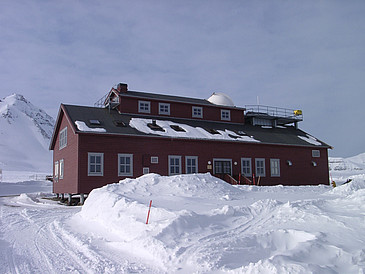In the frame of the study, data from 45 measuring stations across the world was analyzed. Two of the said measuring stations are located in Bremen and on the North Atlantic island group Spitzbergen , which belongs to Norway. The Institute of Environmental Physics (IUP) at the University of Bremen operates the hanseatic station. The IUP as well as the Alfred Wegener Institute (AWI) in Bremerhaven and the French polar institute IPEV operate the one in Spitzbergen. Since 1992, the station in Spitzbergen has been providing valuable information, for example on how the ozone layer in the troposphere is changing and what the reason for this is. “Various methods are implemented. Our contribution is measurements with the Fourier Transform Infrared Spectrometer (FTIR),” explains Professor Justus Notholt, who worked on the current study together with Dr. Matthias Palm.
For these measurements, the sun is the light source. “The ozone in the atmosphere absorbs a part of the sunshine. On the ground, we are measuring the reduced rays of sunshine in the infrared spectral range. However, as we know how many rays were available at the support edge of the atmosphere, we can derive the ozone concentration from the difference,” states Notholt.
Decrease in Traffic Has an Effect
The result of the new study, which has been reviewed internationally by independent scientists, is that the harmful ozone decreased by an average of seven percent in the northern hemisphere in the spring and summer of 2020. “The reason for this is the related decrease in traffic,” according to Matthias Palm. Traffic is the number one source of nitrogen oxide in the atmosphere and it affects the ozone concentration. Thanks to the corona-related lockdown, the pandemic has ensured that there is far less traffic worldwide. On average, the worldwide emissions from travel on land decreased by around 14 percent in 2020 – air travel even by 40 percent.
“That also leads to the seemingly contradictory situation that due to the lockdown an increase in ozone levels close to Earth has been registered globally in urban areas with highly polluted air,” says Justus Notholt. The reason: In highly polluted air close to the emission sources, the nitrogen oxide emitted by the traffic destroys the ozone. “Thus, less traffic means less ozone depletion.” The opposite is the case in relatively clean air in the free troposphere: There, less nitrogen oxide leads to less ozone, as has been observed in the northern hemisphere. Thanks to the lockdown, less nitrogen oxide was emitted into the atmosphere and therefore less ozone was produced in the free troposphere.
International Agreement Could Improve Air Quality
The scientists state that there is a noticeably large and widespread decrease. The unplanned “large-scale corona test” shows clearly how complex the atmosphere can react to a reduction in emissions. However, it also shows what could be achieved with internationally agreed upon measures for worldwide air quality.
The study was published in English in Geophysical Research Letters and is available for download here: https://doi.org/10.1029/2020GL091987
Contact:
Prof. Dr. Justus Notholt
Institute of Environmental Physics
Faculty of Physics / Electrical Engineering
University of Bremen
Phone: +49 421 218-62190
E-Mail: jnotholtprotect me ?!iup.physik.uni-bremenprotect me ?!.de

